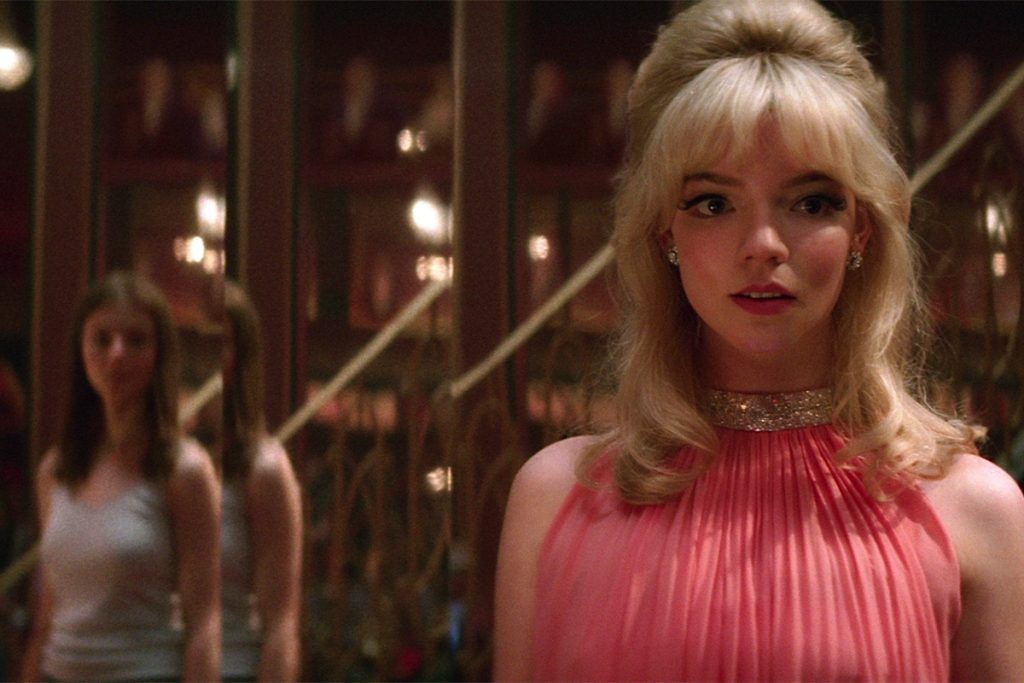Acclaimed director Edgar Wright’s first experimentation in horror Last Night In Soho comes with a delightful 60s soundtrack as well as astounding cinematography-including a continuous shot where two actresses are switched out while dancing with another cast member.
Unfortunately, the film missteps with its messy pacing, mixed messages on a very relevant and sensitive topic, and disjointed narrative devices. Viewers are left pondering if what they saw was a tasteful commentary on how Hollywood treats women or a nightmarish fever dream.
The story follows Eloise (Ellie)Turner (Thomasin McKenzie) an aspiring fashion designer living in a small country town on the outskirts of London. She ventures to the London School of Fashion to pursue and enhance her abilities. There she meets her snobby roommate Jocasta (Synnove Karlsen) and her posse as well as gentle and understanding John (Michael Ajao).
Ellie, fed up with the ignorance of her privacy and overall mental well-being by her roommate, rents a room out from a docile but stern old woman Ms. Collins (Diana Rigg, in her final big-screen role). Ellie is fascinated with the vintage vibes the apartment encapsulates. In between the pastel-dusted lampshades and an old bistro sign that flashes outside of her window every night, Ellie soon discovers an extraordinary gateway into the 1960s through fervent dreams involving a young starlet named Sandie (Anya Taylor-Joy).
At first, the dreams allow Ellie an escapist fantasy. She delves deep into the world of Sandie’s innermost desires and dreams. After a few nights, however, Ellie realizes the sinister price to pay for stardom and learns of London’s tainted past.
The film plays with its visuals the most. Warm vivid colors in the dream sequences crash with the subtle grey hues of the London landscape Ellie inhabits during the day. The cinematography-from the very first shot-gives the audience multiple accounts of eye candy, allowing viewers to be swept up and immersed in this world- the good and the ugly.
The film’s soundtrack also stands out for its prolific inclusion of popular 60s songs including Don’t Throw Your Love Away, Starstruck, and A World Without Love from musical icons The Searchers, The Kinks, and Peter and Gordon.
Undoubtedly Mckenzie’s and Taylor-Joy’s performances as the two leading ladies are captivating in both their composure of emotionality and their similarity in portraying such unique but acquainted, complex young women. Taylor-Joy delivers a haunting performance as Sandie, carefully constructing each movement her character makes rather physically or verbally.
The film falters in its pacing and climax both are a conglomerate mess of familiar horror tropes, cringeworthy prolonged montages, and overlapping plot points that are tied up in a convoluted, archetypal bow. Wright’s projects often retain that exact amount of knowledge of their purpose executed masterfully. It’s clear here, that Wright’s lack of understanding the film’s overarching message denied him the ability to craft a thought-provoking, compelling cinematic experience.
The film plays around a lot with sexism and toxic masculinity. An introductory scene shows Ellie arriving in London and getting in a cab with an over-complementary and straight-up creepy driver-giving viewers a small taste of the language that the men in the movie will use and how it will negatively impact the women around them.
In the film’s conclusion, however, a clustered, chaotic ending culminates into a reversal of the very messages the film was trying to send. Introducing morality and the complicity of rape culture, the film institutes a new proposition that sends viewers into a mixed signals frenzy.
With the increased relevance of women’s issues in society, films need to pay crucial attention to how they are perceived in a way that could potentially be damaging to women as well as invigorate or vindicate men’s entitled attitude towards the autonomy of women.
In essence, Last Night In Soho stands in a realm of possible potential within films that are turned from a promising idea to a rude misconstruing.
The trailer for Last Night In Soho premiered on May 25th, 2021 6 months before its October release. The trailer’s view count today stands at almost 6 million with comments applauding the ambiguous and intriguing nature of the trailer.
Fans of Edgar Wright were riled up with the announcement of this film. With credited films, Baby Driver, Hot Fuzz, and Scott Pilgrim Vs The World, Edgar Wright has cemented himself as one of the most creative and inventive directors of modern cinema. Again, Last Night In Soho’s cinematography speaks for Wright’s impeccable execution of clear-cut visionary shots.
The result of all this anticipation was mostly positive as the film currently sits with a critics-certified 75% on Rotten Tomatoes and a 90% audience satisfaction score. The film’s lacking elements do seem to have surpassed certain viewers’ expectations while others are finding raw emotion and vibrant storytelling.
A few watches will certainly influence viewers differently and may even allow for more acute interpretations of this film. As for Last Night In Soho’s development, it will only take time to recognize the true impact this film will have on modern cinema.

